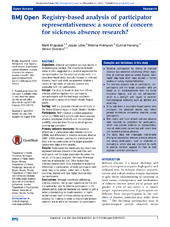| dc.description.abstract | Objectives: Selective participation can bias results in epidemiological surveys. The importance of health status is often suggested as a possible explanation for non-participation but few empirical studies exist. In a population-based study, explicitly focused on sickness absence, health and work, we examined whether a history of high levels of sickness absence was associated with non-participation. Design: The study is based on data from official sickness absence registers from participants, non-participants and the total target population of the baseline survey of the Health Assets Project (HAP). Setting: HAP is a population-based cohort study in the Västra Götaland region in South Western Sweden. Participants: HAP included a random population cohort (n=7984) and 2 cohorts with recent sickness absence (employees (n=6140) and non-employees (n=990)), extracted from the same overall general working-age population. Primary outcome measures: We examined differences in participation rates between cohorts (2008), and differences in previous sickness absence (2001–2008) between participants (individual-level data) and non-participants or the target population (group-level data) within cohorts. Results: Participants had statistically significant less registered sickness absence in the past than nonparticipants and the target population for some, but not all, of the years analysed. Yet these differences were not of substantial size. Other factors than sickness absence were more important in explaining differences in participation, whereby participants were more likely to be women, older, born in Nordic countries, married and have higher incomes than non-participants. Conclusions: Although specifically addressing sickness absence, having such experience did not add any substantial layer to selective participation in the present survey. Detailed measures are needed to gain a better understanding for health selection in healthrelated surveys such as those addressing sickness absence, for instance in order to discriminate between selection due to ability or motivation for participation. | en_US |

